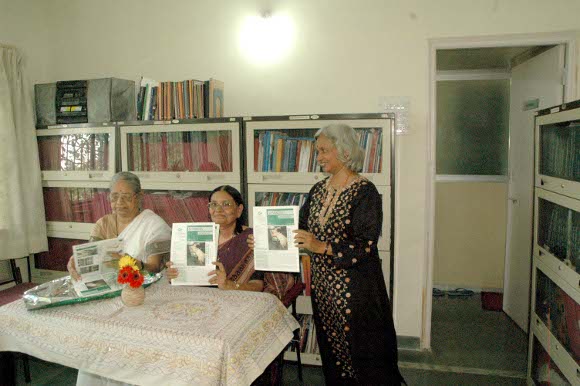Q. Tell us about the Sound and Picture Archives for Research on Women. How did SPARROW start, and why?
A. SPARROW was started in 1988, basically because the Founder Trustees – Dr Neera Desai, Dr Maithreyi Krishna Raj and me, who were friends, – were using a lot of source material for women’s history, like diaries, letters of women, autobiographies… which were considered by the academic world as ‘soft’ material… and the hard material was official documents and other things. We felt that if we have to do women’s histories, then our source materials have to be different. And if the source materials were different, then there should be a place where they should be kept ... housed. We also thought that there were so many other visual materials involved, like photographs, ads, posters, films … all of which, inform you about women’s history. That’s how we decided to set up SPARROW. In the ‘80s, it was fashionable to name organisations, Shakti, Kali etc. I didn’t want that kind of definition. I wanted something that denotes freedom – freedom to think, freedom to act, freedom to change…. So we named it SPARROW.
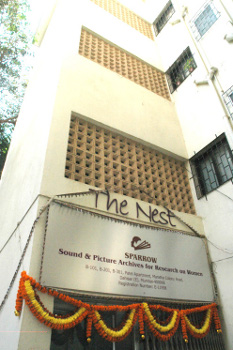
Inauguration of SPARROW's own nest where it shifted to in 2008. Pic: SPARROW Collections
Q. What kind of projects do you undertake and what are the ongoing projects?
A. For the projects that we do, please look up our website. All our ongoing projects are oral history projects – interviews with women … very in-depth, long interviews. We interview women from various walks of life. And we don’t like to define them as ‘feminist’ interviews. I don’t want to define feminism either, because I feel that women of my mother’s generation took many feminist decisions, not knowing that they were feminist decisions, like in the question of education of their daughters or marriage of their daughters. And I think the definition of feminism is about leading a non-degraded life. So I consider all these women feminists. I feel that collecting and archiving knowledge about women’s lives is the only way to bring about change. I consider this is very much a part of development that we are talking about. And development is not just in terms of quantification – by giving hundred sewing machines to hundred widows. I feel that by archiving knowledge about women, we can also decide what kind of voice we give women and how that can decide about policies for women.
Currently, we are doing the fifth and the last volume – of 87 writers from 23 languages. It has interviews with each writer. And we select three poems or a story. I have a painter friend, Bharti Kapadia, and she illustrates the stories. So we bring three things together. And I feel this is the way of chronicling the lives of women, because more than anything else, what I call the ‘politics of everyday life’ needs to be recorded.
Q. You have a comprehensive collection of women’s histories gathered over the years. What insights have you gained from them? Is there a pattern discernible?
A. I don’t see a pattern. And in all these collections, what I’ve learnt is to see is the variety of experiences. And what I see as a common element in all these women’s lives is, I wouldn’t like to address any woman as a victim. They are all survivors. The worst kind of experiences … and they come out of it. If they’ve survived all these years, it’s because they clearly understood what the thing (social system) was. And I find that many women have survived through manipulation of the power relations within the family. All of them are very aware of what exactly is the status of women. And I wouldn’t say that because some women have achieved something, the status of women has changed completely in India. We have a long way to go. And it’s possible that some of our women sometimes are even better off than Western women. Western women are also struggling. I feel it’s a global struggle at different levels. In our country, the major problem is also the economic problem that women have. Not all of them earn their own living. And women who earn their living, like agricultural labourers … how much control do they have over what they earn? These are the questions.
So I feel that if they continue to be in a way oppressed, it’s also because the economy of the nation makes it like that, not because they don’t have the moral strength. And sometimes, if they do give in, it’s because they feel that struggling doesn’t get them anything. Like if a daughter has to be married off by giving dowry, they succumb. They compromise, not because they believe in it, but because they feel that if I hold on to my views, maybe my daughter will never get married. But with present-day women, I feel there’s a lot of confusion about what exactly is tradition and what is modernity. Tradition is not something static. Tradition is also changing all the time. If you see all the sculptures, women wore very different clothes then. We’ve changed a lot and wear very different dresses now. So I feel that all of us are breaking traditions all the time, but we are breaking them in different ways, that’s all.
Q. What long-term purpose does documenting and archiving of women’s stories serve, in your opinion? Has it been an agent of change?
A. One of the things that these materials, right now the way they are, do is that they allow people to look at women’s lives differently. And secondly, when I bring women’s history into the public sphere, then it’s like rekindling memories. People tend to forget history very easily because we get lost in contemporary issues, and we have to keep reminding ourselves of the ways we have been appreciated, of the ways we have succeeded, of the ways we have been hurt and the ways we have got over those hurts and how we continue to live. These stories are very important. Sylvia Plath talks about the bell jar. I think these things are to be kept that way for display. Only then you’ll keep remembering them. And especially the present generation needs to know history differently. Not from the books. And I don’t think these women [who have been interviewed] will ever find their ways into history books. So we’ve to write women into history and we’ve to do it differently. The final goal is to set up a museum of women’s history – that’s the final very ambitious goal – and a digital library.
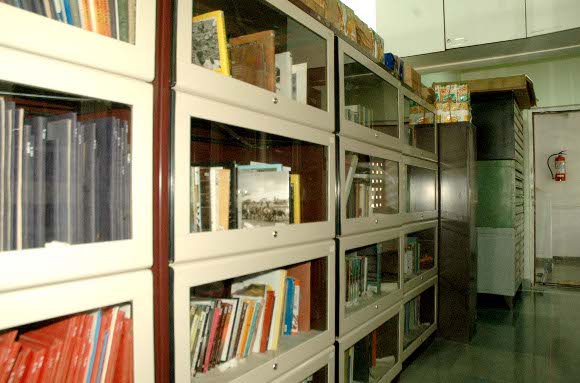
A section of the SPARROW Library. Pic: SPARROW Collections
Q. Are people using the archived material for research?
A. Yes, they do. It’s a repository of many different kinds of research material. And professors bring like 20 students to visit SPARROW. And they come for a one-day workshop. And we also take them for a SPARROW walk so that they can see the different kinds of material.
Q. And it being an agent of change?
A. You see, the work we do is qualitative work. An activist can claim, ‘I’ve done this much of awareness raising and so many people’s lives have changed because I set up hundred self-help groups.’ I can’t make those claims. I can’t measure what we do quantitatively. But I do feel that when I do these workshops, from the kind of response I get, certain questions and certain answers have been planted in their minds. Like that, maybe some change will come. It may not be immediate, and I don’t believe in that kind of immediacy. Even if I’ve made a few people think, that’s enough for me. I hope it brings about some change … the way people read these life stories, and maybe policy-makers can make different policies.
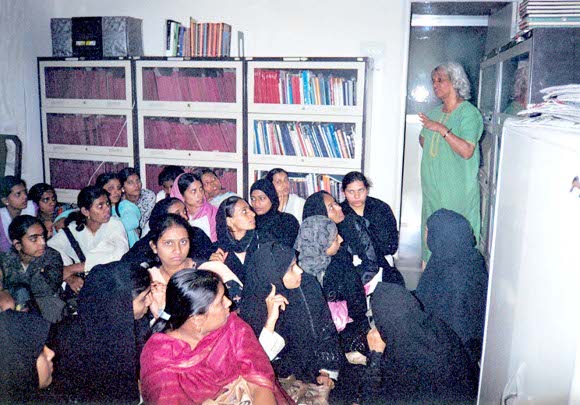
Dr C S Lakshmi with college students during a networking programme at SPARROW. Pic: SPARROW Collections
Q. Women’s stories – the very telling of it can be emancipatory, isn’t it? It’s also a fight against social erasure of women’s experiences and a way of validating them. Is SPARROW trying to do that – validating and stopping the erasure of women’s experiences and memories from the public domain – stopping the dehistoricising of women?
A. Certainly, and not only from the public domain, but also from the familial space. And yes, speaking about their lives is an emancipatory experience for women. There are times when I’ve talked to women where we’ve cried together. They narrate a certain incident and they choke, and both of us cry. And then there are times when we laugh about so many things. These women perhaps had never expressed such personal emotions before. So I feel expressing those emotions and naming them and giving words to them is very liberating.
Q. It’s tradition and patriarchy that victimise women. In fact, men themselves are often entrapped in this skewed value system, which is heavily loaded against women. In this sense, don’t you think women are often the worst enemies of women, as they perpetuate female oppression in the name of tradition and patriarchal norms?
A. Let me tell you this: I have very strong objection to the term ‘women oppressing women’. It’s a question of patriarchal values and how power plays a big role in a family … familial relationships. Suppose a man is a factory owner and there are male workers and they’re oppressed, nobody says a man is oppressing a man. They always say a factory owner is oppressing the workers. Similarly, I feel, being in the position of a mother-in-law, it’s a power position. So we have to locate it like that. The first thing men tell you is women oppress women; women perpetuate tradition. I don’t want to agree with that at all. I feel that there are a set of patriarchal values which women also imbibe. Sometimes they use it manipulatively to survive themselves, and sometimes they play with power relations with those patriarchal values, because unless they have that power, their own existence sometimes in the family is threatened. Tradition and patriarchal values are perpetuated by both women and men for various personal reasons and personal advantages.
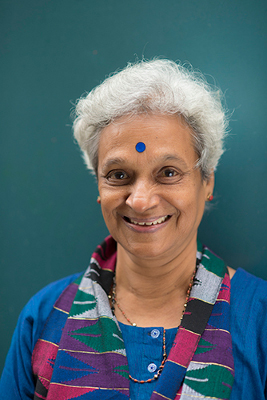
A profile picture of Dr C S Lakshmi. Pic: SPARROW Collections
Some people say that if we want to break oppression, we’ve to break the family. So, if you don’t have a family, do you have an alternative system in which people can exist? I feel that people like us are working towards it. For example, I consider many of my friends as my extended family because their children grow up in my house. I feel it’s for our generation who belong to the movement to have this extended family that’s beyond blood relations.
Q. The term women’s empowerment is often an overused and abused one, and has been reduced to empty symbolism or mere tokenism. What does it mean in real terms to a rural, uneducated woman? What can women’s organisations do to go beyond vacuous gestures and really empower such women?
A. I feel that women’s organisations working both in urban and rural areas, instead of empowerment, keep referring to it as creating awareness. And they do it in many small ways. You can’t educate an adult rural woman. But you can make her think about educating her daughter. Many such changes have come about, which I feel is also a way of teaching a woman that she has agency, she can take decisions. Also, when it comes to a marriage, there are incidents where a rural girl has said, I won’t give dowry and marry. The dowry may only be a cycle or a transistor radio. But she refuses. So I feel that in many different ways, this works.
Q. Has space for women shrunk, despite women’s empowerment?
A. I think the physical space, for example, in terms of places where a woman can go after certain timing may have changed. But where work space and other spaces are concerned, physical space has been given, but the mentality of people they work with has not always changed. In a particular office there may be 50% women and 50% men. But the way these men look at women over the years may not have changed. So it’s not just a question of a woman becoming a prime minister or chief minister in India. The basic attitudes must change. Unless that changes, even if we are given a wide space, it will look shrunk.
Q. Women are expected to scale steep glass cliffs before they reach the glass ceiling. It often becomes a double bind – women, especially in the Indian context, have not been able to shed their traditional roles, but are taking on new ones, having to prove themselves all the time, everywhere. In this sense, it becomes another trap in the name of empowerment. Your views?
A. Women were getting educated in the early part of the [20th] century. Everybody said it’s going to affect her marriage … her mannerisms. She may lose her femininity. But whenever we’ve tried to change a certain way of living, a certain way of working … everywhere we’ll get a double bind – we have to do two things. Even men have to do two things, although the bind on them is not so strong – of performing in companies and coming home and being a nice husband. So despite the double bind, or whatever you call it, women are able to do so many things. So I don’t see it as an entrapment, as much as a phase we are going through. I think there’ll come a phase when we go beyond this double bind and don’t feel restricted, because there are so many different ways of doing well at home nowadays, and not necessarily playing a particular role – taking the essence of that role and doing it in a particular way.
Q. Coming back to feminism itself, Western feminist theories and discourse tend to unversalise a particular concept of feminism. At least, that’s how it used to be. But the problems women face in the Indian context are inextricably entwined with our unique gendered realities. Even within India, caste and class further complicate these issues. What do you think are the challenges Indian women face?
A. I think even globally, now they tend to talk about global feminisms. They are not talking about one feminism, because in a Latin American country or in Africa, India or any other developing country, the way they look at a woman’s life and the way they think of solutions and empowerment may be different. And I think the challenges before us, like any other developing country, is to make women a part of the economic challenge of the country, and not ignore women’s voices, where economy is concerned, politics is concerned and the family is concerned.
Inauguration function of Dr Neera Desai Memorial Library, 2009. Pic: SPARROW Collections
There was a time when women’s studies centres – they wanted to call them “Women and Family Studies Centres”. We objected to it. Many of the women’s studies centres said, nothing doing. Family is studied in Sociology-Anthropology. Why should it be linked with women alone, as if men don’t belong to families? So I feel we’ve to be very careful how we approach nomenclatures. These are the challenges. They are intellectual challenges – an intellectual challenge to take part in what are considered national debates. And I feel it’s happening. And we are up to that intellectual challenge.
Q. In India, when a Dalit woman is raped, the nuances are different, because, for her it’s a double marginalisation – she’s a woman and a Dalit. Caste here becomes important. So what kind of empowerment would apply here?
A. When a Dalit man himself is considered somebody totally below, and the Dalit woman is considered part of his family, empowering Dalit woman alone will not take care of the problem. I feel that the major issue is regarding caste. It’s not just an issue of rape. It’s also a question of humiliation, like women are denuded and asked to walk on the road…. So, it’s a major issue of caste being discussed as a national debate, and why caste exists and what’s the oppressive nature of caste and how women become the objects of oppression in this caste system. They may be oppressed as women in their family and then they are oppressed as being Dalit women. So how are we going to deal with this, unless caste is addressed? It’s not a question of just solving the issue of rape. It’s the question of solving the entire issue of existence of a particular community. So I feel it’s a much, much larger issue.
Q. Women as writers, too, face discrimination. As you have said elsewhere, they are called ‘women writers’, while men are just called writers. This essentialises women’s writing. How does one deal with such a reductionist attitude?
A. Apart from constantly opposing it, there’s no other way, because constantly they refer to you as a woman writer. They introduce you as such – ‘Ambai is a woman writer’. In one meeting I said, look, the fact that I’m a woman is pretty obvious. Why are you adding it all the time? So I don’t think this reductionist attitude will change unless we keep protesting and ridiculing it. If someone tells me we want to give you a certain award as a woman writer, I tell them, keep it; I don’t want it. But for example, SPARROW does give literary awards. And we do award women writers. But we do it as a celebration of their writing. We give an annual award – in Tamil we give it to a woman and a man. Since it’s been instituted by a Tamil gentleman, we give two awards in Tamil. And we give it to one other language writer also. I feel that there’s a need to celebrate women’s writing by awarding them, not because they are women writers, but because they are good writers who happen to be women.


